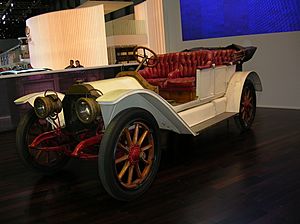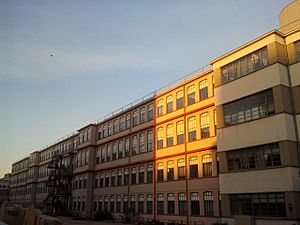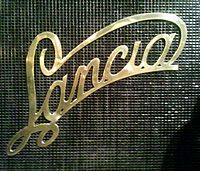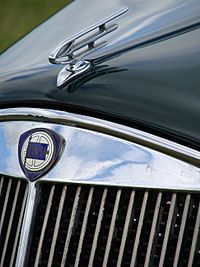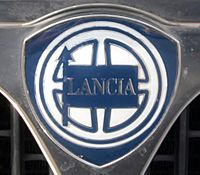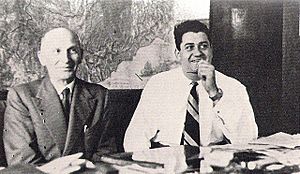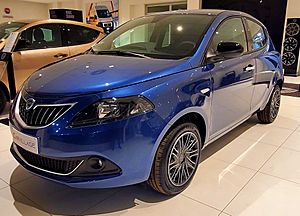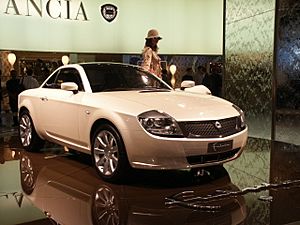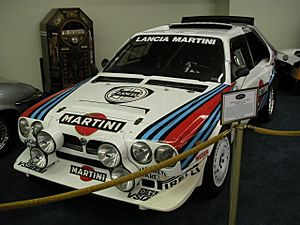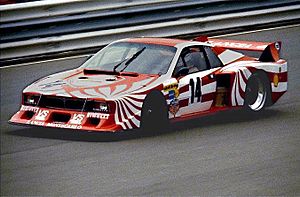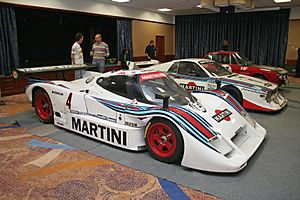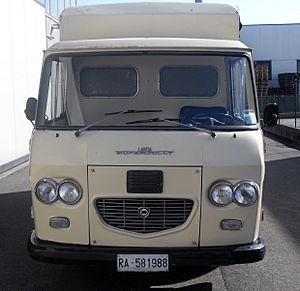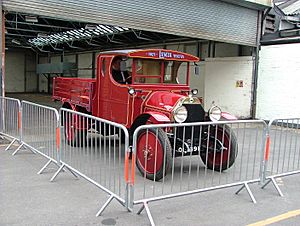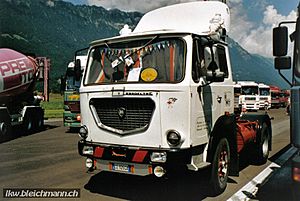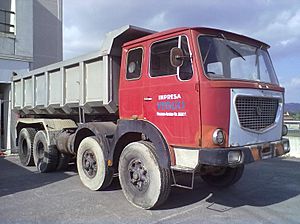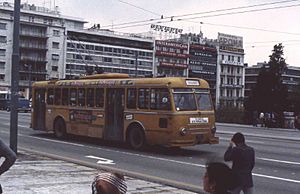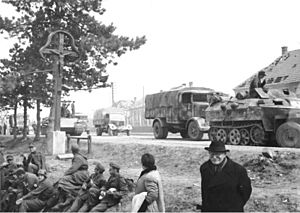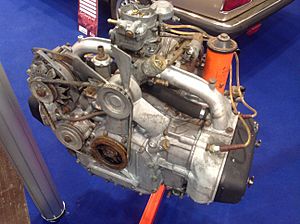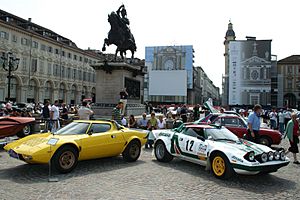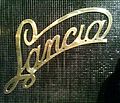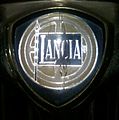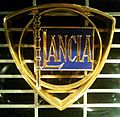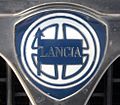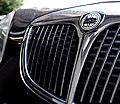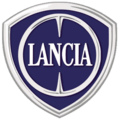Lancia facts for kids
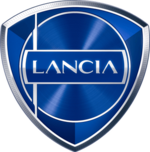 |
|
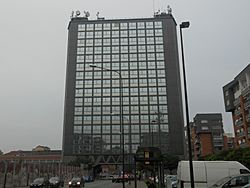
Palazzo Lancia, former company headquarters
|
|
| Subsidiary (S.p.A.) | |
| Industry | Automotive |
| Founded | November 27, 1906 |
| Founder | Vincenzo Lancia |
| Headquarters | Turin, Italy |
|
Area served
|
Italy |
|
Key people
|
John Elkann (Chairman, Stellantis) Luca Napolitano (CEO) |
| Products | Automobiles |
|
Production output
|
43,076 (2020) |
| Owner | Stellantis |
| Parent | Stellantis |
Lancia is an Italian car company that makes automobiles. It is part of a bigger company called Stellantis. Lancia was started in 1906 in Turin, Italy, by Vincenzo Lancia and Claudio Fogolin. Later, in 1969, it became part of Fiat.
Lancia is famous for its success in rallying, which is a type of car racing. They are also known for creating new car technologies. For example, in 1922, their Lambda car had a special body design called a unibody chassis, where the body and frame are one piece. In 1948, the Ardea was one of the first cars to have a five-speed gearbox. Lancia has won more Manufacturers' Championships in the World Rally Championship than any other brand.
Over the years, Lancia's car sales went down. In 2009, after Fiat joined with Chrysler, Lancia started selling Chrysler cars with the Lancia name (this is called rebadging) in Europe. In the United Kingdom, Lancia cars were sold as Chryslers. Sales kept dropping, and by 2017, Lancia only sold cars in Italy. Their main car is now the Lancia Ypsilon, which is still very popular in Italy.
The new company, Stellantis, which owns Lancia, plans to bring the brand back to life. This means Lancia might make more than one car model and start selling cars outside Italy again soon.
Contents
History of Lancia
How Lancia Started
Lancia & C. Fabbrica Automobili was founded on November 27, 1906. It was started in Turin, Italy, by two racing drivers from Fiat: Vincenzo Lancia and his friend, Claudio Fogolin.
Their very first car was called the "Tipo 51" or "12 HP" (later known as "Alfa"). It was made from 1907 to 1908. This car had a small four-cylinder engine that produced about 28 horsepower.
In 1910, Lancia parts were sent to the United States. There, they were put together and sold as SGV cars. In 1915, Lancia also started making trucks, with the Jota being their first.
New Ideas and Changes
Lancia became known for adding many new ideas to their cars. For example, the Theta car in 1913 was the first European production car to have a full electrical system as a standard feature.
The Lambda, made from 1922 to 1931, was special because it had a monocoque chassis. This means the car's body and frame were built as one strong piece, making it lighter and safer. It also had a unique front suspension system.
In 1948, the Series 3 Ardea was the first production car to have a 5-speed gearbox. Lancia also created the first full-production V6 engine in the Aurelia car in 1950. They were also the first to make a V4 engine.
Lancia also used independent suspension in their cars. This is where each wheel can move up and down on its own, making the ride smoother. They also used rear transaxles, which combine the gearbox and axle at the back of the car.
Because Lancia focused so much on new ideas and high quality, their cars were almost handmade. This made them very expensive to produce. Eventually, this high cost and lower demand caused problems for the company.
Lancia Under New Ownership
In 1937, Vincenzo Lancia passed away. His wife, Adele Miglietti Lancia, and his son, Gianni Lancia, took over the company. They brought in Vittorio Jano, a famous engineer who had designed many successful Alfa Romeo race cars.
Gianni Lancia was in charge from 1947 to 1955. He spent a lot of money on new car designs and projects that didn't make much profit. Because of this, he sold a large part of the company to the Pesenti family in 1956.
In October 1969, Fiat bought Lancia because the company was losing a lot of money. However, Fiat wanted to keep Lancia's special image. They released new models in the 1970s like the Stratos, Gamma, and Beta.
During the 1970s and 1980s, Lancia became very successful in rallying, winning many World Rally Championships.
In 2007, Fiat changed how its car companies were organized. A new company, Lancia Automobiles S.p.A., was created. In 2011, Lancia started selling cars that were actually Chrysler models, but with the Lancia badge. This was done in many European countries. In countries like the United Kingdom, Lancia-built cars were sold as Chryslers.
In 2021, Lancia became part of a new company called Stellantis. Stellantis plans to bring Lancia back to its former glory. They announced new electric car models, including a replacement for the Ypsilon, a compact SUV, and a new Delta car.
Lancia's 115th Anniversary
In 2021, Lancia celebrated 115 years since it was founded. The CEO, Luca Napolitano, and chief designer, Jean-Pierre Ploué, marked the occasion with a special film called Elegance on the move.
Lancia Logos Over Time
Lancia's logo has changed several times throughout its history.
- 1907: Early Lancia cars didn't have a badge, just a metal plate with the company name. Some had a brass "Lancia" sign on the front grille.
- 1911: The first real Lancia logo was designed by Count Carlo Biscaretti di Ruffia. It was a round badge with a blue lance (which is what "Lancia" means in Italian) and a flag with the Lancia name. This was placed over a steering wheel design. The Gamma 20 HP was the first car to use this logo.
- 1929: The logo got its well-known shape: the round badge was placed on a blue shield that looked like a triangle with rounded sides. This design became common on cars like the 1936 Aprilia.
- 1957: The logo changed to a more modern, open metal design. The shield and steering wheel became chrome outlines, with only the blue flag part still colored.
- 1974: The badge was redesigned to a simpler, modern silver, white, and blue version of the 1929 design. The lance and flag were combined into one shape.
- 2007: The current logo was introduced. It keeps the traditional chrome-framed blue shield but removes the lance and flag. The steering wheel is now a simple chrome circle with spikes pointing to the Lancia name.
The Lancia Family
The Lancia company was founded by Vincenzo Lancia.
- Vincenzo Lancia was born in 1881. His father wanted him to be a lawyer, but Vincenzo was more interested in science and cars. He became a famous test driver for Italian car brands. In 1922, he married Adele Miglietti, and they had three children: Gianni, Eleonora, and Maria. Vincenzo passed away in 1937.
- Gianni Lancia was born in 1924. He loved sports and car racing. He became the head of Lancia in 1950. Gianni spent a lot of money on new car designs and projects. This led him to sell a large part of the company in 1957. After that, he worked in the food industry. Gianni passed away in 2014.
Lancia Cars
| Year | Cars |
|---|---|
| 1990 | 300,087 |
| 1991 | 265,172 |
| 1992 | 223,127 |
| 1993 | 163,636 |
| 1994 | 163,535 |
| 1995 | 162,416 |
| 1996 | 159,251 |
| 1997 | 176,211 |
| 1998 | 175,215 |
| 1999 | 161,019 |
| 2000 | 170,348 |
| 2001 | 134,812 |
| 2002 | 110,529 |
| 2003 | 108,989 |
| 2004 | 118,201 |
| 2005 | 115,543 |
| 2006 | 122,956 |
| 2007 | 118,036 |
| 2008 | 113,307 |
| 2009 | 113,810 |
| 2010 | 97,757 |
| 2011 | 100,007 |
| 2012 | 98,733 |
| 2013 | 71,223 |
| 2014 | 69,835 |
| 2015 | 61,652 |
| 2016 | 67,059 |
| 2017 | 60,620 |
| 2018 | 48,555 |
| 2019 | 58,759 |
Current Car Models
Lancia Ypsilon
The Lancia Ypsilon is a small, fancy 5-door car. It has been made since 2011. It used to be sold in many European countries, but since 2017, you can only buy it in Italy. In the United Kingdom and Ireland, it was sold as the Chrysler Ypsilon. Even though it's the only Lancia car made right now and only sold in Italy, the Ypsilon is very popular there. It was the second best-selling car in Italy in 2019.
Past Car Models
Famous Older Models
The Lancia Aurelia was a very important car. It was one of the first to have its engine in the front and its gearbox in the back. This design was later used by other famous car makers like Ferrari and Porsche. The Aurelia also introduced the V6 engine, which is now very common.
The Lancia Stratos was a super successful rally car in the 1970s. It helped Lancia become famous in car racing.
Cars Based on Chrysler Models
For a few years, Lancia sold cars that were actually Chrysler models with a Lancia badge.
- The Lancia Thema (2011-2014) was a rebadged Chrysler 300. It was sold in Europe, but in the UK and Ireland, it was still called the Chrysler 300C.
- The Lancia Voyager was a big family van (MPV) that came out in 2011. It was based on the Chrysler Town & Country. In the UK and Ireland, it was sold as the Chrysler Grand Voyager.
- From 2012 to 2014, the Chrysler 200 Convertible was sold as the Lancia Flavia. It was only available in countries where cars drive on the right side of the road.
These rebadged models were stopped in 2015.
Concept Cars
Lancia has shown many concept cars. These are special cars made to show new ideas or designs that might be used in future cars. Some examples include the Stratos Zero (1970) and the Fulvia concept (2003).
Special Cars
Lancia has also made unique cars for special purposes.
- In the late 1960s, Lancia made a special landaulet-limousine called the Lancia Flaminia 335 Presidenziale for the President of Italy.
- In 1989, Lancia made a limousine version of the Thema. Only 24 of these were made for Fiat-Group leaders.
Where Lancia Cars Were Sold
United States
Lancia cars were sold in the United States from 1975, but sales were slow. The brand left the US market in 1982.
Later, in 2009, Fiat (which owned Lancia) teamed up with Chrysler. They planned for Lancia and Chrysler to share car designs. Some Chrysler cars would be sold as Lancias in Europe, and some Lancia cars would be sold as Chryslers in other markets.
United Kingdom
Lancia's reputation in the United Kingdom was hurt in 1980. Many Lancia Beta cars had a problem with rust in their suspension. Lancia had to buy these cars back from owners, and they were later crushed. This event was widely reported and made people lose trust in the brand.
Because of this and other issues, Lancia stopped selling cars in the United Kingdom in 1994. The last model sold there was the Delta.
In 2011, some Lancia models, like the Ypsilon and Delta, were brought back to the UK, but they were sold under the Chrysler name. However, sales were still slow, and the Chrysler brand was eventually stopped in the UK in 2017.
Lancia in Racing
Formula One
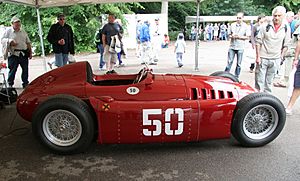
After Vincenzo Lancia's son, Gianni Lancia, became the company director, Lancia started to get more involved in motorsport. They decided to build a Grand Prix car for Formula One racing.
Their car, the Lancia D50, raced in 1954. Famous driver Alberto Ascari even got the fastest lap. But in 1955, Ascari was sadly killed in an accident while driving another car. Because of his death and Lancia's money problems, the company stopped racing in Formula One. Lancia had two wins and ten podium finishes in Formula One.
The remaining parts of the Lancia racing team were given to Scuderia Ferrari. With a Lancia-Ferrari car, Juan Manuel Fangio won the 1956 Formula One championship.
Rallying
Lancia has been incredibly successful in rallying, which is a type of car race on public or private roads. Before the official World Rally Championship (WRC) began, Lancia won a major title with its Fulvia car in 1972.
In the WRC, Lancia is still the most successful brand, even though they stopped competing in 1993. They won many constructors' titles (awards for the car maker) with cars like the Stratos (1974, 1975, 1976), the 037 (1983), and the Delta (six wins in a row from 1987 to 1992). The Lancia Delta is also the most successful car model ever in rallying. Overall, Lancia has won 11 World Rally Championships.
Drivers like Juha Kankkunen and Miki Biasion each won two driver titles with the Delta. However, Lancia's rallying history also has sad moments. Two drivers, Attilio Bettega and Henri Toivonen, died in accidents during rallies in 1985 and 1986. These tragedies led to the end of a very fast and dangerous type of rallying called Group B.
Sports Car Racing
Lancia also raced sports cars from the late 1970s to the mid-1980s. Their Beta Montecarlo Turbo was very successful, winning major championships in 1980 and 1981.
In 1982, Lancia introduced the LC2 sports car, which had a Ferrari engine. The LC2 was very fast, getting 13 pole positions (starting first in a race). However, it often had problems and used a lot of fuel. Because it couldn't consistently beat the dominant Porsche cars, Lancia stopped sports car racing in 1986 to focus on rallying.
Lancia Commercial Vehicles
Lancia also made many different types of commercial vehicles, like vans, trucks, and buses. They started a special division for this in 1912. Lancia stopped making these vehicles in the early 1970s, after Fiat took over the company. Some of their models were then made by Iveco.
Light Commercial Vehicles
- 1958 Lancia Ardea Furgoncino (van), Cassone (pick-up)
- 1950 Lancia Beta
- 1953 Lancia Appia Furgoncino (van), Camioncino (pick-up)
- 1959 Lancia Jolly
- 1963 Lancia Superjolly
Heavy Commercial Vehicles
Lancia made many large trucks, including:
- Lancia Jota (1915)
- Lancia Ro (1932)
- Lancia 3Ro (1938)
- Lancia Esatau (1947)
- Lancia Esadelta (1959)
- Lancia Esagamma (1969)
Buses and Trolleybuses
Lancia also produced buses and trolleybuses (buses powered by overhead electric lines). Some examples include:
- Lancia Omicron (1927)
- Lancia Esatau (bus) (1947)
- Lancia Diafa trolleybus (1966)
Military Vehicles
Lancia made vehicles for the military, such as:
- Lancia 1Z (light truck, 1912)
- Lancia 1ZM (armoured car, 1912)
- Lancia 3Ro (truck, 1938)
- Lancia Lince (armoured car, 1942)
Lancia Engines
Lancia developed several types of engines for its cars and other vehicles:
- Lancia Flat-4 engine
- Lancia V4 engine
- Lancia V6 engine
- Lancia V8 engine
- Lancia Tipo 4
The company also made engines for industrial uses.
Lancia in Media
In 2009, the British TV show Top Gear said that Lancia had more "great" car models than any other company. The presenters tested many Lancia cars, saying they made the best-looking cars, even if they sometimes had reliability issues.
Lancia also sponsored the Venice Film Festival for five years, ending in 2012. Their Lancia Thema cars were used to drive famous people to the festival.
Images for kids
 In Spanish: Lancia para niños
In Spanish: Lancia para niños


